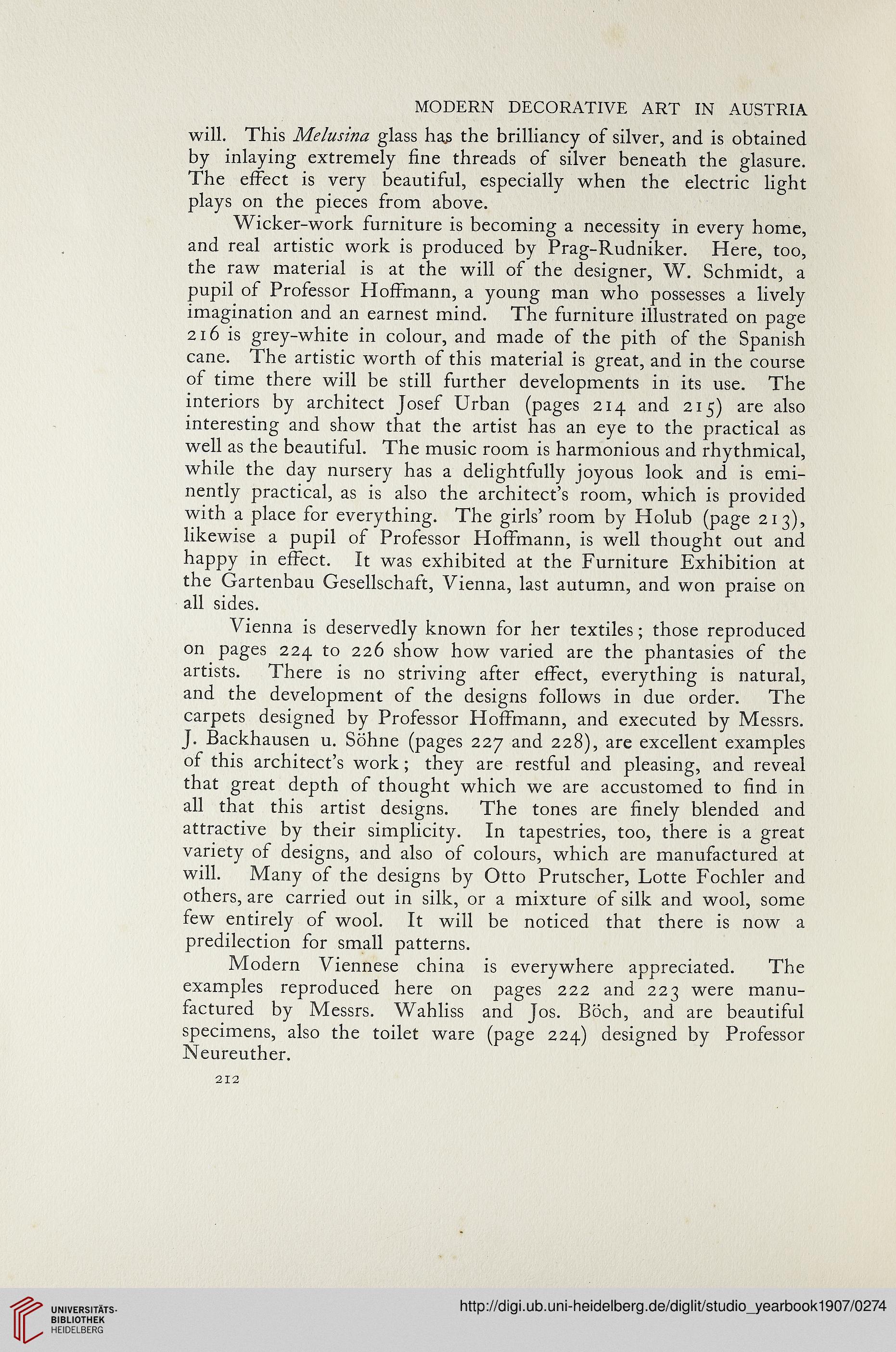MODERN DECORATIVE ART IN AUSTRIA
will. This Melusina glass has the brilliancy of silver, and is obtained
by inlaying extremely fine threads of silver beneath the glasure.
The effect is very beautiful, especially when the electric light
plays on the pieces from above.
Wicker-work furniture is becoming a necessity in every home,
and real artistic work is produced by Prag-Rudniker. Here, too,
the raw material is at the will of the designer, W. Schmidt, a
pupil of Professor Hoffmann, a young man who possesses a lively
imagination and an earnest mind. The furniture illustrated on page
216 is grey-white in colour, and made of the pith of the Spanish
cane. The artistic worth of this material is great, and in the course
of time there will be still further developments in its use. The
interiors by architect Josef Urban (pages 214 and 215) are also
interesting and show that the artist has an eye to the practical as
well as the beautiful. The music room is harmonious and rhythmical,
while the day nursery has a delightfully joyous look and is emi-
nently practical, as is also the architect’s room, which is provided
with a place for everything. The girls’ room by Holub (page 213),
likewise a pupil of Professor Hoffmann, is well thought out and
happy in effect. It was exhibited at the Furniture Exhibition at
the Gartenbau Gesellschaft, Vienna, last autumn, and won praise on
all sides.
Vienna is deservedly known for her textiles; those reproduced
on pages 224 to 226 show how varied are the phantasies of the
artists. There is no striving after effect, everything is natural,
and the development of the designs follows in due order. The
carpets designed by Professor Hoffmann, and executed by Messrs.
J. Backhausen u. Sohne (pages 227 and 228), are excellent examples
of this architect’s work; they are restful and pleasing, and reveal
that great depth of thought which we are accustomed to find in
all that this artist designs. The tones are finely blended and
attractive by their simplicity. In tapestries, too, there is a great
variety of designs, and also of colours, which are manufactured at
will. Many of the designs by Otto Prutscher, Lotte Fochler and
others, are carried out in silk, or a mixture of silk and wool, some
few entirely of wool. It will be noticed that there is now a
predilection for small patterns.
Modern Viennese china is everywhere appreciated. The
examples reproduced here on pages 222 and 223 were manu-
factured by Messrs. Wahliss and Jos. Boch, and are beautiful
specimens, also the toilet ware (page 224) designed by Professor
Neureuther.
will. This Melusina glass has the brilliancy of silver, and is obtained
by inlaying extremely fine threads of silver beneath the glasure.
The effect is very beautiful, especially when the electric light
plays on the pieces from above.
Wicker-work furniture is becoming a necessity in every home,
and real artistic work is produced by Prag-Rudniker. Here, too,
the raw material is at the will of the designer, W. Schmidt, a
pupil of Professor Hoffmann, a young man who possesses a lively
imagination and an earnest mind. The furniture illustrated on page
216 is grey-white in colour, and made of the pith of the Spanish
cane. The artistic worth of this material is great, and in the course
of time there will be still further developments in its use. The
interiors by architect Josef Urban (pages 214 and 215) are also
interesting and show that the artist has an eye to the practical as
well as the beautiful. The music room is harmonious and rhythmical,
while the day nursery has a delightfully joyous look and is emi-
nently practical, as is also the architect’s room, which is provided
with a place for everything. The girls’ room by Holub (page 213),
likewise a pupil of Professor Hoffmann, is well thought out and
happy in effect. It was exhibited at the Furniture Exhibition at
the Gartenbau Gesellschaft, Vienna, last autumn, and won praise on
all sides.
Vienna is deservedly known for her textiles; those reproduced
on pages 224 to 226 show how varied are the phantasies of the
artists. There is no striving after effect, everything is natural,
and the development of the designs follows in due order. The
carpets designed by Professor Hoffmann, and executed by Messrs.
J. Backhausen u. Sohne (pages 227 and 228), are excellent examples
of this architect’s work; they are restful and pleasing, and reveal
that great depth of thought which we are accustomed to find in
all that this artist designs. The tones are finely blended and
attractive by their simplicity. In tapestries, too, there is a great
variety of designs, and also of colours, which are manufactured at
will. Many of the designs by Otto Prutscher, Lotte Fochler and
others, are carried out in silk, or a mixture of silk and wool, some
few entirely of wool. It will be noticed that there is now a
predilection for small patterns.
Modern Viennese china is everywhere appreciated. The
examples reproduced here on pages 222 and 223 were manu-
factured by Messrs. Wahliss and Jos. Boch, and are beautiful
specimens, also the toilet ware (page 224) designed by Professor
Neureuther.




